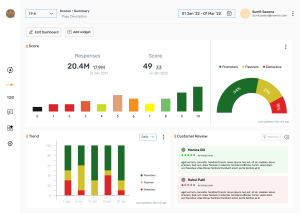Voice of customer of VOC is an integral part of customer experience CX teams. It dictates customer satisfaction, their needs, wants, expectations and preferences from the brand. This is a long step process for every marketing professional. It includes collecting their reviews, online testimonials, and analyzing customer feedback and sentiments for continuous business upgrade.
Successful voice of customer programs will enhance the CX of a company. A good CX can bring a massive competitive edge among top performers in the market. VOC campaigns are important to ensure that a customer input is requested, validated and executed.
Every data collected is a reflection of what a customer or a buyer feels towards a company. Since it is a long process, this involves multiple investigations of a user’s interaction with a company. Assessing their social media conversations about the brand, their monetary transaction of products/services, their interaction on websites and applications and range of customer feedback on different channels.
Why is the VoC Dashboard important in Customer Experience Management?
Analyzing the voice of customer data is required to capture the needs and wants of your patrons at every step of the customer journey. Here are some main reasons why a VoC dashboard is an integral part of CX.
- The customer support, marketing and sales team need data to attend to customers. A dashboard makes it easier to compile journey mapping information in one place. This makes it simpler for teams to collaborate and decide their next step of action. This way, they can map out needs, wants, and attend to negative reviews from people.
- Customer sentiment analysis is a good metric to track if a company has promoters or detractors. It can detect possible churn, happy customers or indifferent buyers. This way, you can map a customized set of solutions for every segment of buyers.
- A VoC dashboard allows businesses to analyze customer sentiment, response rates, and feedback, helping them identify pain points, areas for improvement, and best practices. It provides a strategic framework for incorporating customer feedback into the decision-making process, enabling businesses to align their customer experience strategy with the needs and preferences of their target audience.
- Negative experience can drive customers away and damage the reputation of the brand. A positive customer experience can lead to increased customer satisfaction, loyalty, and advocacy. A good CX has become a key differentiator for businesses across industries.
- A well equipped VoC dashboard can understand customers in real time, monitor performance and mark them against key metrics. This can map issues at touchpoints, capture people’s voices and opinions and create reports for your business’s roadmap.
Key features of a successful voice of customer metrics dashboard
To maximize the value of a VoC dashboard, it is essential to track the right voice of customer metrics at the right time.:
- Real-time Monitoring: A good VoC dashboard captures real-time monitoring of customer feedback, enabling businesses to respond promptly and address customer concerns in a timely manner.
- Comprehensive Customer Feedback: The dashboard should gather feedback from multiple channels, including surveys, social media, and customer support interactions, to provide a comprehensive view of the customer experience.
- Net Promoter Score (NPS) and CSAT Score Analysis: A successful VoC dashboard incorporates the analysis of NPS scores and customer satisfaction (CSAT) scores, which provide insights into customer loyalty and satisfaction levels.
- Customer Sentiment Analysis: By leveraging natural language processing (NLP) techniques, the dashboard should analyze customer feedback to identify sentiment patterns, both positive and negative. This enables businesses to understand customer sentiment and make data-driven decisions.
- Actionable Insights: A well-built VoC dashboard provides actionable insights derived from customer feedback analysis, helping businesses identify improvement areas and take proactive measures to enhance the customer experience.

3 Steps to Conduct the Voice of Customer Analytics
Compiling a set of narrative from your buyers becomes difficult without data to support it. A dashboard can streamline the way you collect information shared digitally, detect sentiment metrics and segregate information against these metrics. Use these customer insights to make strategic decisions and upgrade business CX.
Collect customer data from multiple channels of communication:
People have conversations that can get hard to track. Some of the crucial conversations can get hard to track. To collect these reviews and conversations, deploy automated surveys across various channels after interactions. This includes after financial transactions, customer service calls and website based chat bot surveys.
Omnichannel data also includes human to human interaction during live chat on websites, customer service phone support calls, support emails and website chatbots and survey responses via SMS, WhatsApp or Facebook messenger applications. Gathering real time conversations and survey data also brings rich insights into the voice of customer dashboards.
Conduct voice of customer analysis of customer data:
It can get overwhelming to analyze a plethora of consumer data right off the bat. Hence we need the assistance of artificial intelligence to segregate metrics and responses.
- AI in VoC analysis can eliminate duplicate data, remove inconsistencies and biased or rigged entries. Technology is very efficient when it has to segregate complex conversations, identify underlying themes and understand common pain points.
- Sentiment analytics can segregate emotions based on structured or unstructured data. AI based text analysis will bring context and emotional context behind every feedback.
- Word cloud segregation and open ended responses also need human intervention to identify pain points and close feedback loops. Open-ended qualitative customer response needs manual assessment for human intervention and a realistic solution.
Enable dashboards to report and present the analytics:
This is when marketing departments and sales teams need data visualisation tools to make sense of the data. This uses charts, bar graphs, word cloud segregation and automatic report generating process. This is a faster process and it is easier to interpret these insights without missing crucial details.
A tailored VoC dashboard need not have manual intervention. It can compile complex information and make sense out of unstructured data and create them into actionable insights. It goes beyond quantitative metrics to show you exactly why a certain topic or sentiment is trending right now. This process is easier for organisations that are larger and collect hundreds or thousands of online reviews and conversations on a daily basis. This way, CX and customer service teams can come up with targeted resolution strategies and make data-driven voc strategies.
Examples of Voice of Customer Questions and Templates
An important point to note is that CX teams can only act on genuine responses. While curating surveys or a 3 question template survey, keep it precise, to the point and goal oriented. Additionally, ensure that the platform is interactive such that customers do not have to move to a high friction browser. This will prevent them from giving a response. After all, no company wants to feel ghosted by their own user base!
1. “How would you rate the service received today?”
This is the most common after-service question launched for every customer. Along with a 5 point star rating metrics, leave a space for an open-ended response. This allows people to elaborate on why they have shared a certain rating for products or services received. For example “Please share your reason for choosing this rating:”
2. The common “recommendation metric” of net promoter score question
“On a scale of 1 to 10, how likely are you to recommend our products/ services?”. This popular net promoter score or NPS question is created to detect detractors, promoters or passives (people who are indifferent). Even though this might gauge the overall satisfaction from a loyal consumer, there will also be a window to create brand advocates out of a ‘passive’ consumer.
3. “What features of our product/services are important to you?”
This question can come with a set of tick boxes mentioning every feature of the product or service. This becomes easier for product development teams to pinpoint on the exact features and work on them. Additionally, leave room for an open-ended feedback space such that people can share their views without bias. Product managers can identify qualitative and quantitative responses for continuous evaluation.
These common questions can bring precise yet actionable feedback. Marketing professionals can curate survey questions according to the products and services offered, position of the customer in the journey process, and overall business goals.
Voice of the Customer Program Best Practices: 3 Points Can Maximize CX
A well defined VoC process can detect success, identify friction points and provide early warnings. Use these metrics to realise continuous improvement in your VoC program.
Encouraging cross-departmental collaboration
To enhance customer experience, it’s vital to encourage collaboration between teams and sharing and utilization of voc program insights. In this manner, team members can develop strategies that align with customer expectations. Leveraging the voice of the customer dashboard allows for the internal use of feedback data in a customer-centric approach, ensuring that all departments are aligned in delivering exceptional experiences.
Visualizing VoC data in real-time
In real-time, the voice of the customer dashboard (VoC) enables businesses to gather, analyze, and visualize customer feedback promptly. This rapid access to data empowers companies to swiftly make well-informed decisions and promptly address customer concerns. The VoC dashboard offers a comprehensive overview of customer feedback from various channels such as social media, surveys, and customer support interactions. By visualizing this data, businesses can easily track progress, identify trends, pinpoint areas for improvement, and recognize opportunities for product or service enhancements. This will positively impact the overall brand CX.
Regularly updating the VoC dashboard
To ensure the VoC dashboard remains effective, it’s essential to continuously collect and analyze customer feedback from omnichannel platforms. Real-time metrics play a crucial role in tracking customer sentiment and pinpointing areas for improvement. Furthermore, ongoing optimization of the VoC dashboard is vital, involving the integration of new metrics and feedback channels to proactively address evolving customer needs.
By adhering to these practices, organizations can elevate their VOC program and voice of the customer analysis, leading to sustained success in customer experience management.

Use the Right Voice of Customer Tools to 10X your CX:
The following are the right voice of customer tools for your business and their main features:
Merren: Deploy superfast customer feedback surveys, capture real time feedback and quickly segregate qualitative and quantitative data. Higher than industry-average response rate with pre-designed templates and integrations. Capture customer feedback and sentiments, omnichannel.
Medallia: Marketers can get a holistic view of the customer journey while analyzing customer responses from multiple applications. Conduct in-depth sentiment analysis and detect promoters and detractors with their tools.
Qualtrics: This is a comprehensive platform that offers multiple integration and customization options. This platform is capable of analyzing structured and unstructured data for various industries.
InMoment: This platform can turn customer feedback into actionable insights and offer instant report generation. They also offer text analytics and various integrations for your business.
Are You Ready to Transform Your Customer Experience with a VoC Dashboard?
Ready to revolutionize your customer experience? Unlock insights, drive data-driven decisions, and enhance customer satisfaction with a voice of customer dashboard. Prioritize CX and invest in technology for valuable results. Are you ready to take the leap?
Conclusion
A well-built voice of customer dashboard can identify consumer suggestions, identify high friction points and drive innovation at the right time. Using AI in a VoC dashboard can streamline fuctions, making it easier for stakeholders to view every data in a segregated and arranged reports. This shows that you are willing to listen and act on the concerns of people. Use the voice of customer analytics on the dashboard and build memorable CX today.
